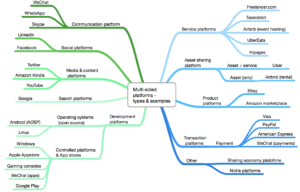Understanding the Platform Economy and On-Demand Work

Written by: Alolika
A research report published by McKinsey suggests that more than 30% of global economic activity, valued at about $60 trillion, could be mediated by digital platforms within a period of six years. Digital platforms, based on a business model that generates value by facilitating interactions between a large number of participants, constitute what is called the platform economy.
The Making Of A Platform-based Gig Economy
There are many types of platform businesses. John Hagel, founder of Deloitte Center, divides all platform businesses into four categories: Aggregation platforms like eBay and Etsy, which bring together a broad array of relevant resources for users; social platforms like Twitter and Facebook, which support engagement among people with common interests; mobilisation platforms like Apache and Linux, which focus on mobilizing participants to engage in a collaborative effort that will take considerable time to accomplish, and learning platforms like Udemy, which facilitate learning by bringing participants together to share insights over time.
Apart from Hagel, there are many other people in Silicon Valley who have tried to differentiate platform businesses. As per Dr. Murat Uenlue of Innovation Tactics, all platform businesses fall into one of the following categories:


These platform businesses together constitute the platform economy. In simple terms, a platform economy is an economy where human activity, including social and economic, is facilitated by platforms. The past decade has witnessed the rise of the platform economy with service-providing platforms such as Uber, Zomato, Urban Company, and Airbnb growing from start-ups to large-scale corporations. It is estimated that the number of service providers involved with various platforms rose from 8.5 million in 2016 to 11.7 million in 2017, and 15 million in 2018. Most businesses today prefer a platform business model because of faster growth, higher efficiency, and better scope for building scalable communities.
In another article as mentioned above, we also discussed design learning for future. Shantanu Bhattacharya, in a response to a question mentioned:
Combining the digital and the physical is a luxury. It assumes that there is a physical space for learning which is available everywhere and to everyone.
The most visible impact of this preference can be seen on employment. Platform businesses are fast becoming the largest employers. “If some of our growth estimates continue, it will not be too many years before we can be the third-largest source of employment in the country, behind the Army and the Indian Railways,” Sriharsha Majety, Co-founder and CEO of Swiggy said in October 2019. Swiggy employed 2.1 lakh delivery partners as of October 2019. Other platforms, such as Ola, have shown similar figures. Ola has a nation-wide network of 2.5 million driver-partners.
At the same time, many sectors dominated by linear businesses are also looking to engage more gig workers and expand into the platform-based gig economy. The FMCG-pharmaceutical sector plans to increase its gig workforce from 15 per cent now to 69 per cent over the coming two to five years, the banking, financial services, and insurance (BFSI) sector plans to ramp up from 32 per cent to 56 per cent, the manufacturing sector from 35 per cent to 65 per cent, the services sector from 47 per cent to 76 per cent, and technology & BPO from 57 per cent to 60 per cent. The EdTech sector, the market for which is expected to touch $3.5 billion – $4 billion by 2022, currently employs about 90,000 gig workers.
What Is In It For Workers?
Platforms are changing the nature of work. They are building a labour market characterised by the prevalence of short-term contracts or freelance work as opposed to traditional, full-time employment. Such freelance jobs are popularly known as gigs and they tend to last a limited period of time, often the duration of a project or as long as the company has a specific need. As of December last year, India had around 15 million gig workers engaged in sectors like IT, HR, and designing. With the rise of the platform economy and the subsequent emergence of various gigs, a large number of workers have started to prefer freelancing with online platforms over working permanent jobs.
Gig work, unlike traditional employment, allows workers to have more control over their place of work, the kind of work they do, the hours they work, their role, their workload, and their pay. It is particularly attractive to young people who seek more independence and flexibility in their jobs, while also wanting to acquire new skills and access new opportunities. A gig worker tends to have a more dynamic work profile; every new project contains different elements and there is a wide variety of projects to choose from. These facilities tend to attract creatives to gig work. There is also the benefit of low commitment: if a gig worker disagrees with the work they are expected to do, or has a poor relationship with the company, it is very easy for them to leave and seek employment elsewhere.
Gig workers have a better chance at maintaining a healthy work-life balance as well since most companies allow them to work remotely. This makes the platform-based gig economy attractive to homemakers, single parents, and caretakers who want to sustain themselves financially while also attending to domestic responsibilities. There is flexibility, independence, dynamism, and work-life balance in the gig economy, all of which are comparatively curtailed in traditional employment.
For many, gig work is a good source of side income. Airbnb, Uber, and Swiggy have helped several people pay their loans or other liabilities they would otherwise not be able to pay for. Since every platform offers a different pay to gig workers—with some paying lower due to the temporary nature of their engagement and some paying higher as they do not have to provide other employment benefits—it is common for gig workers to juggle multiple jobs. This is beneficial in two main ways: financially (creates multiple streams of income) and professionally (diversifies skillset). Added to all these advantages is the ease of employment. What gives these platforms an edge over other employers is how easy and quick it is to start working for them. All a person needs is a phone with an internet connection.
Algorithm Enabled Discrimination – License To Misbehave
The mechanisms or algorithms used in these seemingly neutral platforms may in fact, create conditions that provide opportunities to discriminate based on the gig worker’s gender and social data. According to a 2017 study on bias in the online freelance market places TaskRabbit and Fiverr, the design of the platforms exacerbated social biases and workers’ gender and race significantly impacted their ability to do business, even if the tasks were virtual in nature. There are mainly two input avenues through which the data collected on these sites may lead to discrimination.
First, platforms may require gig-workers to self-report demographic information for verification, and create profiles displaying their names (indicating gender and religion), and headshots to engender consumer trust. On platforms like UrbanClap where the consumer has the option to choose the gig worker, these profiles may allow perceived stereotypes to determine the choice. Even on cab and food delivery aggregators where tasks are assigned by the algorithm based on availability and proximity of the gig worker, consumers may decide to cancel rides or reject deliveries out of prejudice. Notably, in 2019, a Zomato customer attempted to cancel his order and seek a refund or a “non-Muslim rider” after seeing on the app that his food delivery had been assigned to a Muslim rider. Interestingly, the Jabalpur Police issued a bond to the customer under s. 107 & 116 with a promise not to commit “a breach of peace”. But it doesn’t solve the issue of discrimination. While Zomato didn’t acquiesce to the refund in this case, practically, the gig worker would have found it impossible to legally object against the discrimination. One reason is that consumers often reserve the right to cancel tasks or orders in a short window after assignment of the job without incurring a penalty, especially on ride-hailing and food-delivery services. Further, pursuing claims under under anti-discrimination labour law also raises the question of who would be liable. Is the liability on the principal (the aggregator) who is engaging the independent contractor (the delivery rider) under a contract for services, or is the contract between the service user and the independent contractor?
Secondly, in the interests of transparency and efficiency, the search function on these platforms rank workers according to their assessments, display ratings and feedback from previous customers, which impacts workers’ employment prospects. Here, the input data in terms of feedback taken may be influenced by perceived gender and social stereotypes, and the result would be that the mechanisms of the aggregators in fact reinforce the biases and prejudices of the traditional labour market, and result in hiring inequalities. Research has indicated that positive public evaluations reduce gender discrimination against women.[1] The study on TaskRabbit and Fiverr found that the opaque review process enabled potential consumers to act on their pre-existing biases, particularly where user feedback influenced placement of search rankings. Predictably, women and African-American workers were ranked lower, affecting both the volume of work and rates they could commission.
Consequently, gig workers who bear the brunt of these biases that are enabled by or seep into the algorithms may respond to the discrimination by accepting precarious jobs and lower remuneration. For women, the gig economy has often replicated the gender pay gap in the traditional labour market, and research indicates that globally the gap may range from 7-37% across sectors. Studies and experiments have routinely found that women gig workers face discrimination in both hiring and remuneration, as the algorithms enable potential customers to act on notions of women’s capabilities for a job, their productivity, and ability to negotiate rates in a contract.
Ungender Insights is the product of our learning from advisory work at Ungender. Our team specializes in advising workplaces on workplace diversity and inclusion. Write to us at contact@ungender.in to understand how we can partner with your organization to build a more inclusive workplace.
Read our insights about diversity, legal updates and industry knowledge on workplace inclusion at Ungender Insights. Visit our Blog.
Sign up to stay up-to-date with our free e-mail newsletter.
The above insights are a product of our learning from our advisory work at Ungender. Our Team specialises in advising workplaces on gender centric laws.
or email us at contact@ungender.in




